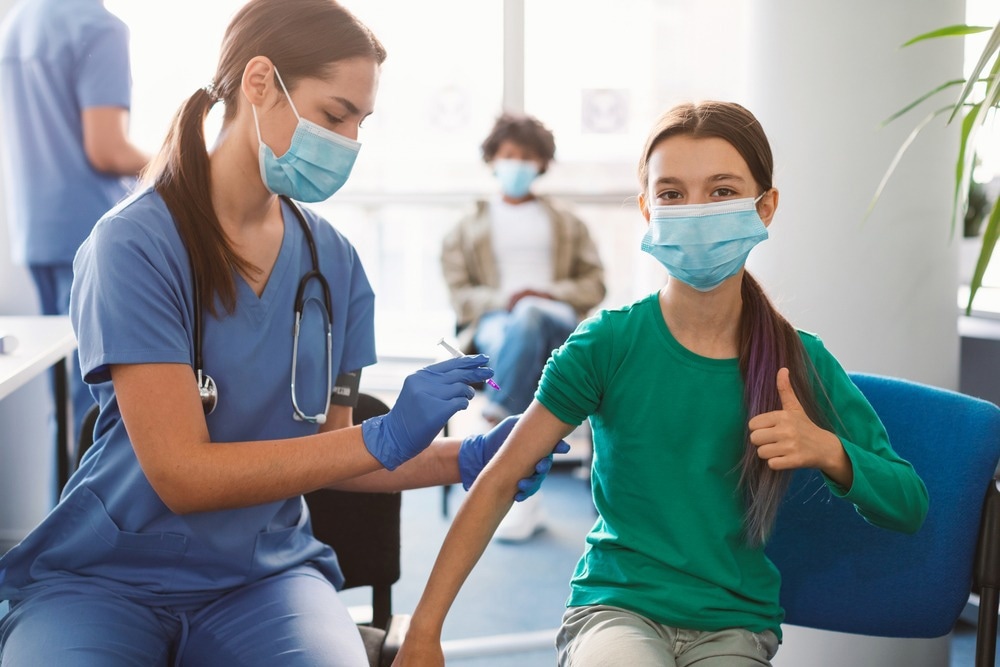The study also outlined the discrepancies in adopting the strategies among 12th-grade United States (US) public-type schools.

Study: Disparities in Implementing COVID-19 Prevention Strategies in Public Schools, United States, 2021–22 School Year. Image Credit: Prostock-studio/Shutterstock.com
Background
During the severe acute respiratory syndrome coronavirus 2 (SARS-CoV-2) pandemic, schools were advised to adopt layered strategies to curb SARS-CoV-2 transmission and continue offline schooling in the US.
Strategies recommended by the Centers for Disease Control and Prevention (CDC) included home stay during illness, optimizing ventilation, practicing proper respiratory etiquette and hand hygiene, performing disinfection and cleaning, and improving COVID-19 vaccination uptake.
Previous studies assessing discrepancies in adopting strategies to prevent COVID-19 focused on only one school district or state and few prevention strategies.
About the study
In the present nationwide study, researchers reported on the second wave data of the national school COVID-19 prevention study (NSCPS), assessing discrepancies in implementing COVID-19 prevention strategies.
These strategies included ventilation, vaccines, disinfection and cleaning, masking, SARS-CoV-2 screening and testing, quarantine, and contact tracing among 12th-grade schools for the schooling period between 2021 and 2022.
The study was conducted between June 2021 and May 2022, during SARS-CoV-2 Delta variant of concern (VOC) predominance, using survey data obtained from 12th-grade public-type schools.
The NSCPS study included schools stratified by region (South, Northeast, West, Midwest), level of education (high, middle, or elementary), and locale (rural, suburb, town, or city), according to the national center for education statistics (NCES) scheme.
Private-type schools, alternative-type schools, those providing services to pull-out populations enrolled at other eligible schools, those managed by the United States defense department, and those with less than 30 students were excluded from the analysis.
In total, the implementation of 21 SARS-CoV-2 infection prevention measures was analyzed using survey data. Data on two characteristics, i.e., employing full-time nurses and having school-based health centers (SBHCs), were obtained.
NSCPS survey data and MDR database records were linked. Data on the student count permitted to receive lower-priced or complimentary meals in the 2019 to 2020 schooling year was used to assess school poverty, and the school locale was classified using the NCES scheme.
County-level data on COVID-19 incidence among every 100,000 individuals in the prior week, reported by the CDC, were obtained. Logistic regression modeling was performed to calculate the adjusted odds ratios (aOR).
Results
Of 1,602 schools invited to participate, 27% (n=437) of schools responded to the surveys, the prime respondents being school nurses and principals.
Prevalence of COVID-19 preventive strategies ranged between nine percent (offered COVID-19 screening and testing to staff and students) and 95% (had school-based systems for reporting SARS-CoV-2 infection outcomes).
Among the schools, 95% had school-based systems to document SARS-CoV-2 infection outcomes, 93% had isolation space, 84% quarantined students who were considered close contacts, 80% adopted cleaning schedules, 75% inspected their heating, ventilation, and air conditioning (HVAC) systems, and 74% maintained at least a three-feet physical distance in the classrooms.
Further, 69% of schools provided COVID-19 testing to staff and students, 67% kept windows open when safe, and 66% implemented mask-wearing.
Only nine percent of schools screened staff and students for COVID-19, 27% utilized high-efficiency particulate air (HEPA) filters, and 31% provided on-site SARS-CoV-2 vaccines.
Schools with middle-level poverty were less likely to have their HVAC systems inspected (aOR 0.4), use HEPA systems (aOR 0.5), and open windows whenever safe (aOR 0.5) compared to those with low-level poverty. Rural schools were less likely to use HEPA systems (aOR 0.4) than schools located in cities.
However, schools in rural areas were more likely to open doors and windows whenever safe, with aOR values of 2.1 and 4.5, respectively, and less likely to need face mask-wearing (aOR 0.4) than those in cities.
Schools with full-time nurses were less likely to open doors whenever safe (aOR 0.6) than those without. Schools with full-time nurses and SHBCs had significantly greater odds of adopting SARS-CoV-2 infection prevention measures and quarantining students who were close contacts than those without. (aOR2.0)
Elementary-level schools were less likely to provide students and parents with SARS-CoV-2 vaccination data, with aOR values of 0.2 and 0.5, respectively, provide on-site SARS-CoV-2 vaccines (aOR 0.5) and track student vaccinations (aOR 0.5) than high-level schools.
Middle-level schools were less likely to provide students with SARS-CoV-2 vaccination data (aOR 0.4), provide vaccines via district-level events (aOR 0.4), and track student/staff vaccination status (aOR 0.4) than high-level schools.
In comparison to schools with low-level poverty, those with high-level poverty were more likely to provide students with SARS-CoV-2 vaccination data (aOR 3.9) and vaccines via district-level events (aOR 2.5).
Schools with middle-level poverty were more likely to provide students and parents with data on receiving missed healthcare services (aOR 1.9) than those with low-level poverty. Schools in rural areas were less likely to provide SARS-CoV-2 vaccination via district-level events (aOR 0.5) and track staff vaccination status (aOR 0.5) than those in cities. Town schools were more likely to track student SARS-CoV-2 vaccinations (aOR 3.1) than those located in cities.
Schools with full-time nurses were likelier to track student SARS-CoV-2 vaccinations (aOR 1.8) than those without. Schools with school-based health centers were more likely to provide on-site SARS-CoV-2 vaccines (aOR 2.0) and SARS-CoV-2 vaccines via school-level districts (aOR 2.3) than those without.
Conclusion
Overall, the study findings highlighted school-based responses to the COVID-19 pandemic.
The study findings could guide health interventions to improve SARS-CoV-2 transmission curtailment, identify schools that must be prioritized for allocating health resources, increase the workforce, and improve infrastructure to enhance preparedness against COVID-19 and future pandemics.
Journal reference:
-
Pampati, S., Rasberry, C.N., Timpe, Z., McConnell, L., Moore, S., Spencer, P., Lee, S., Murray, C.C., Adkins, S.H., Conklin, S. and Deng, X., Disparities in Implementing COVID-19 Prevention Strategies in Public Schools, United States, 2021-22 School Year. Emerging Infectious Diseases, 29(5). doi : https://doi.org/10.3201/eid2905.221533 https://wwwnc.cdc.gov/eid/article/29/5/22-1533_article